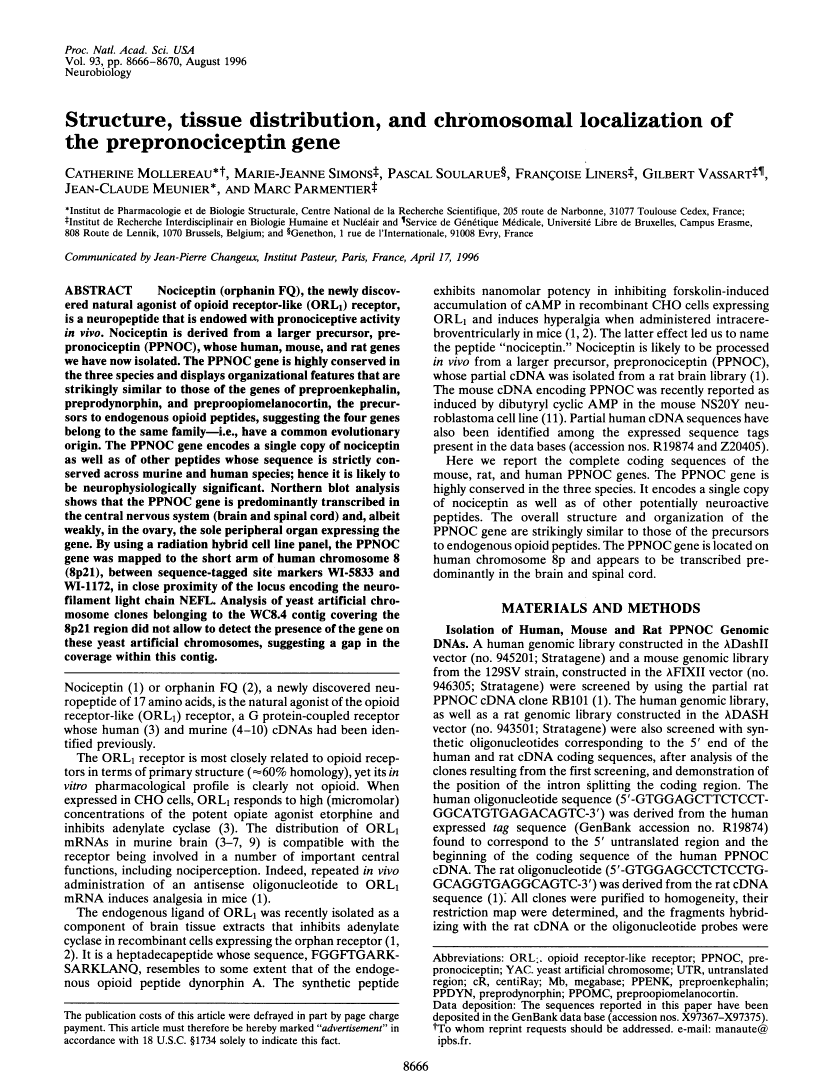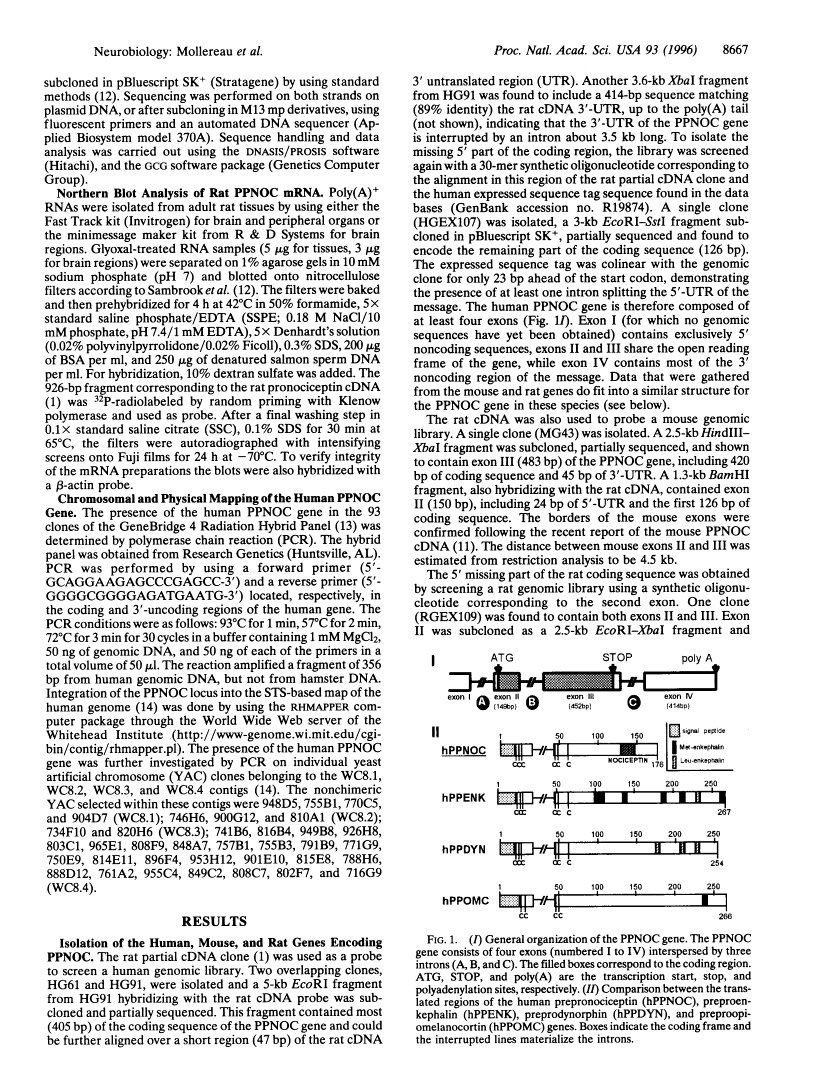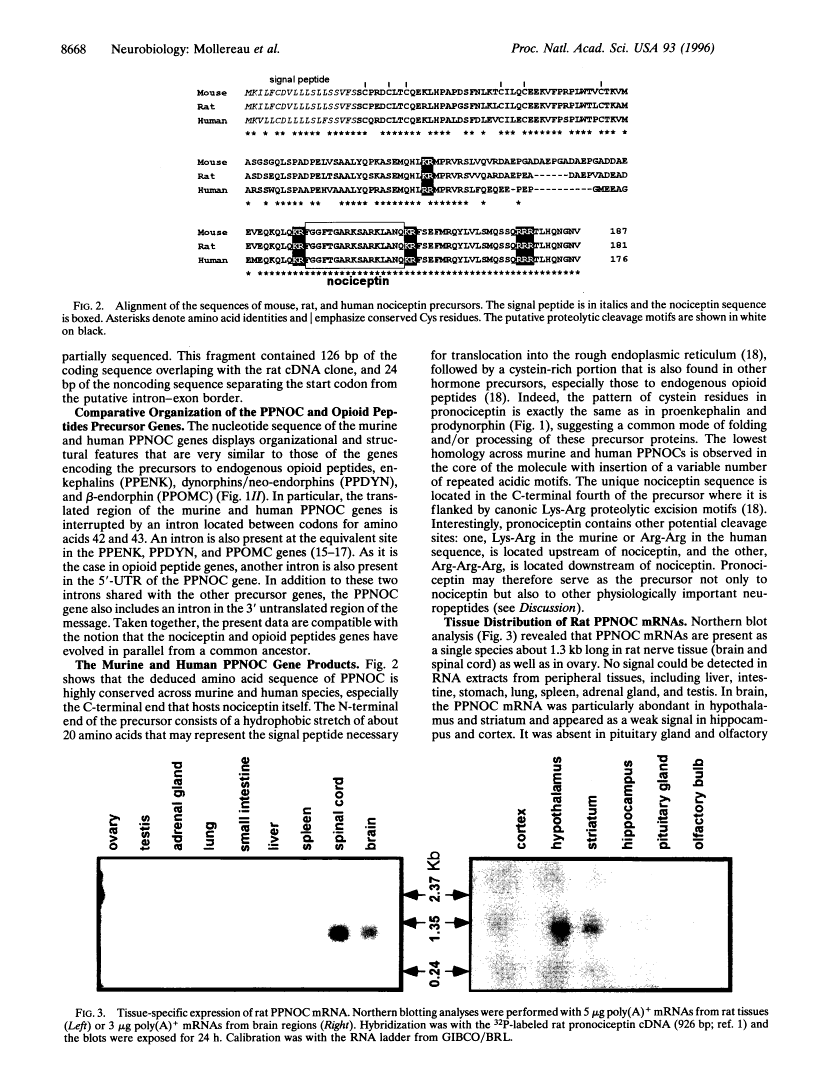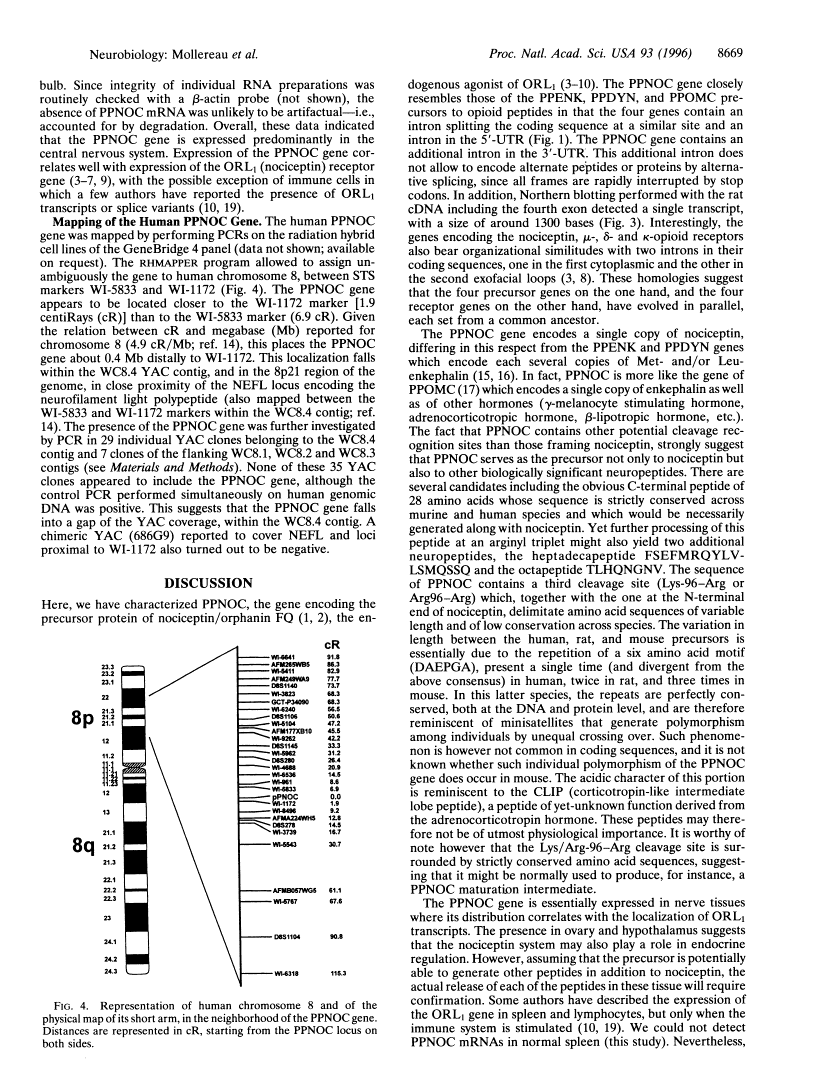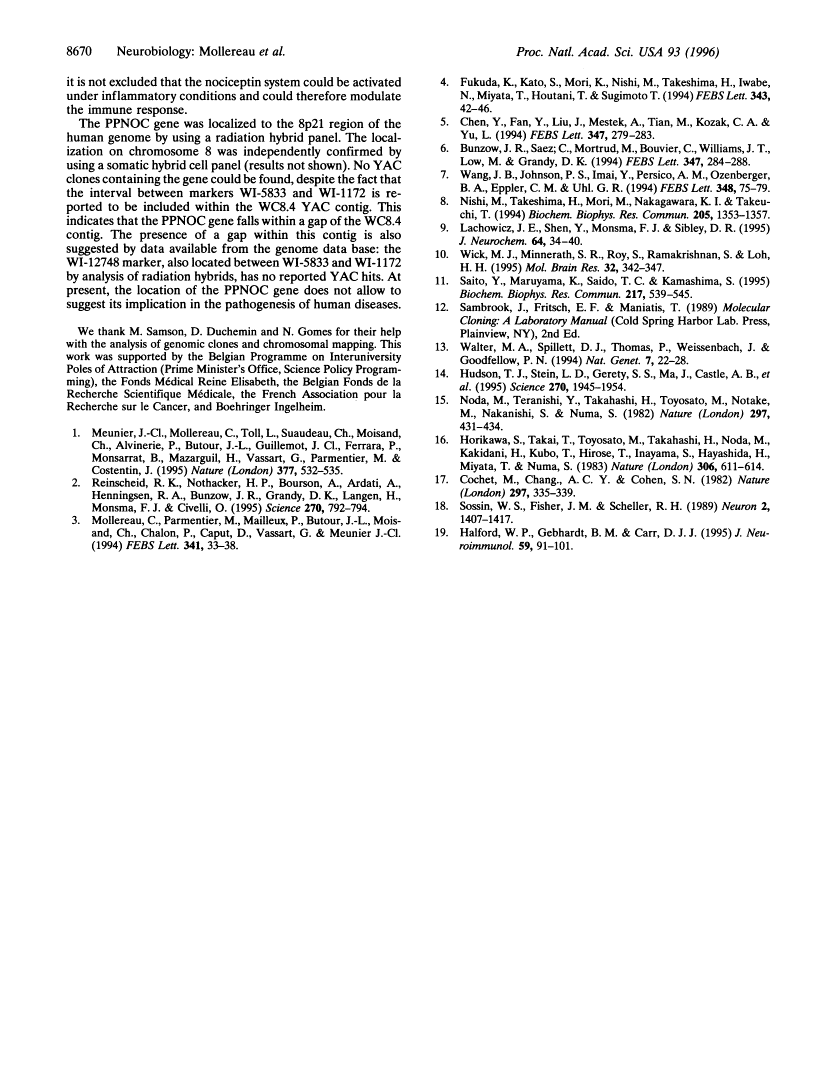Abstract
Free full text

Structure, tissue distribution, and chromosomal localization of the prepronociceptin gene.
Abstract
Nociceptin (orphanin FQ), the newly discovered natural agonist of opioid receptor-like (ORL1) receptor, is a neuropeptide that is endowed with pronociceptive activity in vivo. Nociceptin is derived from a larger precursor, prepronociceptin (PPNOC), whose human, mouse, and rat genes we have now isolated. The PPNOC gene is highly conserved in the three species and displays organizational features that are strikingly similar to those of the genes of preproenkephalin, preprodynorphin, and preproopiomelanocortin, the precursors to endogenous opioid peptides, suggesting the four genes belong to the same family-i.e., have a common evolutionary origin. The PPNOC gene encodes a single copy of nociceptin as well as of other peptides whose sequence is strictly conserved across murine and human species; hence it is likely to be neurophysiologically significant. Northern blot analysis shows that the PPNOC gene is predominantly transcribed in the central nervous system (brain and spinal cord) and, albeit weakly, in the ovary, the sole peripheral organ expressing the gene. By using a radiation hybrid cell line panel, the PPNOC gene was mapped to the short arm of human chromosome 8 (8p21), between sequence-tagged site markers WI-5833 and WI-1172, in close proximity of the locus encoding the neurofilament light chain NEFL. Analysis of yeast artificial chromosome clones belonging to the WC8.4 contig covering the 8p21 region did not allow to detect the presence of the gene on these yeast artificial chromosomes, suggesting a gap in the coverage within this contig.
Full text
Full text is available as a scanned copy of the original print version. Get a printable copy (PDF file) of the complete article (1.3M), or click on a page image below to browse page by page. Links to PubMed are also available for Selected References.
Images in this article
Click on the image to see a larger version.
Selected References
These references are in PubMed. This may not be the complete list of references from this article.
- Meunier JC, Mollereau C, Toll L, Suaudeau C, Moisand C, Alvinerie P, Butour JL, Guillemot JC, Ferrara P, Monsarrat B, et al. Isolation and structure of the endogenous agonist of opioid receptor-like ORL1 receptor. Nature. 1995 Oct 12;377(6549):532–535. [Abstract] [Google Scholar]
- Reinscheid RK, Nothacker HP, Bourson A, Ardati A, Henningsen RA, Bunzow JR, Grandy DK, Langen H, Monsma FJ, Jr, Civelli O. Orphanin FQ: a neuropeptide that activates an opioidlike G protein-coupled receptor. Science. 1995 Nov 3;270(5237):792–794. [Abstract] [Google Scholar]
- Mollereau C, Parmentier M, Mailleux P, Butour JL, Moisand C, Chalon P, Caput D, Vassart G, Meunier JC. ORL1, a novel member of the opioid receptor family. Cloning, functional expression and localization. FEBS Lett. 1994 Mar 14;341(1):33–38. [Abstract] [Google Scholar]
- Fukuda K, Kato S, Mori K, Nishi M, Takeshima H, Iwabe N, Miyata T, Houtani T, Sugimoto T. cDNA cloning and regional distribution of a novel member of the opioid receptor family. FEBS Lett. 1994 Apr 18;343(1):42–46. [Abstract] [Google Scholar]
- Chen Y, Fan Y, Liu J, Mestek A, Tian M, Kozak CA, Yu L. Molecular cloning, tissue distribution and chromosomal localization of a novel member of the opioid receptor gene family. FEBS Lett. 1994 Jun 27;347(2-3):279–283. [Abstract] [Google Scholar]
- Bunzow JR, Saez C, Mortrud M, Bouvier C, Williams JT, Low M, Grandy DK. Molecular cloning and tissue distribution of a putative member of the rat opioid receptor gene family that is not a mu, delta or kappa opioid receptor type. FEBS Lett. 1994 Jun 27;347(2-3):284–288. [Abstract] [Google Scholar]
- Wang JB, Johnson PS, Imai Y, Persico AM, Ozenberger BA, Eppler CM, Uhl GR. cDNA cloning of an orphan opiate receptor gene family member and its splice variant. FEBS Lett. 1994 Jul 4;348(1):75–79. [Abstract] [Google Scholar]
- Nishi M, Takeshima H, Mori M, Nakagawara K, Takeuchi T. Structure and chromosomal mapping of genes for the mouse kappa-opioid receptor and an opioid receptor homologue (MOR-C). Biochem Biophys Res Commun. 1994 Dec 15;205(2):1353–1357. [Abstract] [Google Scholar]
- Lachowicz JE, Shen Y, Monsma FJ, Jr, Sibley DR. Molecular cloning of a novel G protein-coupled receptor related to the opiate receptor family. J Neurochem. 1995 Jan;64(1):34–40. [Abstract] [Google Scholar]
- Wick MJ, Minnerath SR, Roy S, Ramakrishnan S, Loh HH. Expression of alternate forms of brain opioid 'orphan' receptor mRNA in activated human peripheral blood lymphocytes and lymphocytic cell lines. Brain Res Mol Brain Res. 1995 Sep;32(2):342–347. [Abstract] [Google Scholar]
- Saito Y, Maruyama K, Saido TC, Kawashima S. N23K, a gene transiently up-regulated during neural differentiation, encodes a precursor protein for a newly identified neuropeptide nociceptin. Biochem Biophys Res Commun. 1995 Dec 14;217(2):539–545. [Abstract] [Google Scholar]
- Walter MA, Spillett DJ, Thomas P, Weissenbach J, Goodfellow PN. A method for constructing radiation hybrid maps of whole genomes. Nat Genet. 1994 May;7(1):22–28. [Abstract] [Google Scholar]
- Hudson TJ, Stein LD, Gerety SS, Ma J, Castle AB, Silva J, Slonim DK, Baptista R, Kruglyak L, Xu SH, et al. An STS-based map of the human genome. Science. 1995 Dec 22;270(5244):1945–1954. [Abstract] [Google Scholar]
- Noda M, Teranishi Y, Takahashi H, Toyosato M, Notake M, Nakanishi S, Numa S. Isolation and structural organization of the human preproenkephalin gene. Nature. 1982 Jun 3;297(5865):431–434. [Abstract] [Google Scholar]
- Horikawa S, Takai T, Toyosato M, Takahashi H, Noda M, Kakidani H, Kubo T, Hirose T, Inayama S, Hayashida H, et al. Isolation and structural organization of the human preproenkephalin B gene. Nature. 1983 Dec 8;306(5943):611–614. [Abstract] [Google Scholar]
- Cochet M, Chang AC, Cohen SN. Characterization of the structural gene and putative 5'-regulatory sequences for human proopiomelanocortin. Nature. 1982 May 27;297(5864):335–339. [Abstract] [Google Scholar]
- Sossin WS, Fisher JM, Scheller RH. Cellular and molecular biology of neuropeptide processing and packaging. Neuron. 1989 May;2(5):1407–1417. [Abstract] [Google Scholar]
- Halford WP, Gebhardt BM, Carr DJ. Functional role and sequence analysis of a lymphocyte orphan opioid receptor. J Neuroimmunol. 1995 Jun;59(1-2):91–101. [Abstract] [Google Scholar]
Associated Data
Articles from Proceedings of the National Academy of Sciences of the United States of America are provided here courtesy of National Academy of Sciences
Full text links
Read article at publisher's site: https://doi.org/10.1073/pnas.93.16.8666
Read article for free, from open access legal sources, via Unpaywall:
https://europepmc.org/articles/pmc38730?pdf=render
Citations & impact
Impact metrics
Citations of article over time
Alternative metrics
Smart citations by scite.ai
Explore citation contexts and check if this article has been
supported or disputed.
https://scite.ai/reports/10.1073/pnas.93.16.8666
Article citations
SnapHiC-G: identifying long-range enhancer-promoter interactions from single-cell Hi-C data via a global background model.
Brief Bioinform, 25(5):bbae426, 01 Jul 2024
Cited by: 0 articles | PMID: 39222061 | PMCID: PMC11367764
Traumatic Brain Injury Induces Nociceptin/Orphanin FQ and Nociceptin Opioid Peptide Receptor Expression within 24 Hours.
Int J Mol Sci, 25(3):1658, 29 Jan 2024
Cited by: 0 articles | PMID: 38338936 | PMCID: PMC10855772
The Nociceptin/Orphanin FQ peptide receptor antagonist, SB-612111, improves cerebral blood flow in a rat model of traumatic brain injury.
Front Pharmacol, 14:1272969, 18 Oct 2023
Cited by: 1 article | PMID: 37920208 | PMCID: PMC10618424
Temporal and regulatory dynamics of the inner ear transcriptome during development in mice.
Sci Rep, 12(1):21196, 07 Dec 2022
Cited by: 1 article | PMID: 36476755 | PMCID: PMC9729293
Disruption of the glucagon receptor increases glucagon expression beyond α-cell hyperplasia in zebrafish.
J Biol Chem, 298(12):102665, 09 Nov 2022
Cited by: 1 article | PMID: 36334626 | PMCID: PMC9719020
Go to all (149) article citations
Other citations
Data
Data behind the article
This data has been text mined from the article, or deposited into data resources.
BioStudies: supplemental material and supporting data
Similar Articles
To arrive at the top five similar articles we use a word-weighted algorithm to compare words from the Title and Abstract of each citation.
Primary structure and tissue distribution of the orphanin FQ precursor.
Proc Natl Acad Sci U S A, 93(16):8677-8682, 01 Aug 1996
Cited by: 154 articles | PMID: 8710930 | PMCID: PMC38732
Structure and regional distribution of nociceptin/orphanin FQ precursor.
Biochem Biophys Res Commun, 219(3):714-719, 01 Feb 1996
Cited by: 101 articles | PMID: 8645247
Cloning and expression of a cDNA encoding a mouse brain orphanin FQ/nociceptin precursor.
Biochem J, 315 ( Pt 1):11-13, 01 Apr 1996
Cited by: 45 articles | PMID: 8670093 | PMCID: PMC1217157
[Cloning of prepronociceptin has led to the discovery of other biologically active peptides].
C R Seances Soc Biol Fil, 192(6):1099-1109, 01 Jan 1998
Cited by: 1 article | PMID: 10101606
Review
